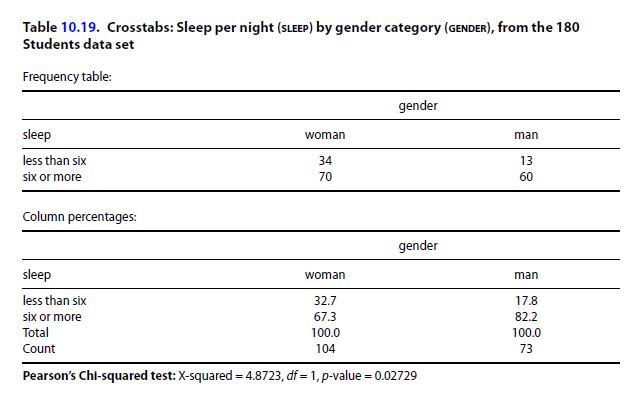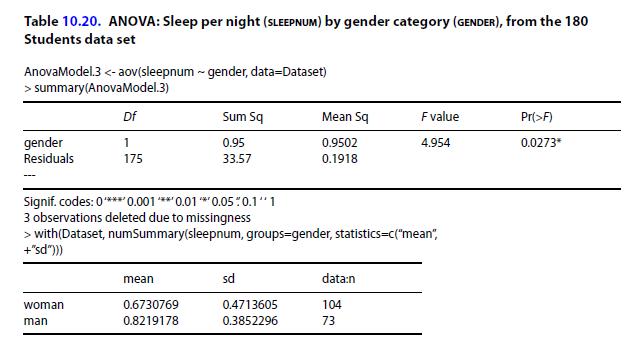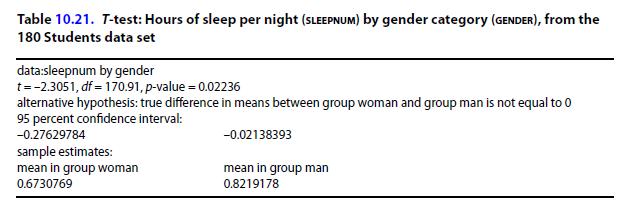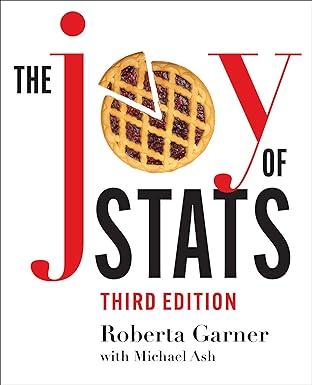For this question, we will look at different ways of analyzing data about whether or not students
Question:
For this question, we will look at different ways of analyzing data about whether or not students get six hours of sleep a night. The tables have been produced from the data file called 180 Students. We are going to use gender as our first predictor variable.
gender was treated as a binary, and so was sleep, so we can use an independent-samples t-test or ANOVA or crosstabs to test whether the two gender categories are equally likely to report six or more hours of sleep. The sleep binary had to be renamed sleepnumb in R-Commander to ensure that it was treated as a numerical outcome variable (0 or 1) rather than as a categorical variable. Any variable that is a factor or group variable has to be coded as a variable with named categories. Any variable that is a response or outcome variable has to be numerical. Because binary variables can be thought of as either categorical or numerical variables, they can be used as t-test group variables, as ANOVA outcome variables, and in crosstabs as categorical variables, but in R-Commander we have to be careful to treat them as numerical variables if they are outcome variables in a compare-means procedure.
Here are the results of the three tests.
Table 10.19 provides the crosstab for amount of sleep per night by gender.

Here is the ANOVA for this comparison.

And Table 10.21 gives the result analyzed with a t-test, which you already saw in Chapter Nine.

Using the results displayed in the previous tables, answer these questions:
a) What proportion of each gender category reported six or more hours of sleep?
b) Was there a statistically significant difference between men and women in the proportion reporting six or more hours of sleep?
c) How would you interpret the confidence interval reported in the t-test?
d) Which test do you find easiest to understand?
We can explore a few questions about student life and study habits using the Study Habits data set compiled and analyzed by Emanuel Henderson. Here is a little more information about the data set.
Henderson was curious whether household income and demographic variables impacted students’ academic experiences and study habits. His initial research hypothesis was that students from higher-income families get better grades, but he did not find strong support for that. His sample was rather small, and not every plausible hypothesis yielded statistically significant results.
Sleepnum or sleep is a binary variable based on the question “Do you usually get six or more hours of sleep or not?” sleep and sleepnum are the same binary variable, as Sleepnum is just a numerical recoding of sleep for R-Commander.
Class2 has been recoded as a binary variable. (It was originally coded as a 4-category ordinal variable based on the Illinois household income distribution.) 0 is the lower income category; and 1 the higher income.
Race3 is a three-category nominal variable, with categories black, white, and other.
I think “race and ethnicity” would be a better variable name, but “race” was shorter.
I feel apologetic about the category label other, but we wanted to avoid categories with really small numbers of individuals; so this category includes students who identified as Latino/a or Hispanic, as Asian, as Pacific Islander, or as Native American. All coding was according to self-identification, and originally Henderson used the same categories as the ones used by the university in its official forms and applications, but these categories were recoded into the three you see here.
read is a three-category variable used to compile and code the way students report that they usually read course material: Nothing means they don’t read any of it; shortcuts means they skim readings or look at things like Wikipedia or online notes; and all means they read everything.
Step by Step Answer:

The Joy Of Stats A Short Guide To Introductory Statistics In The Social Sciences
ISBN: 9781487527297
3rd Edition
Authors: Roberta Garner, Michael Ash





